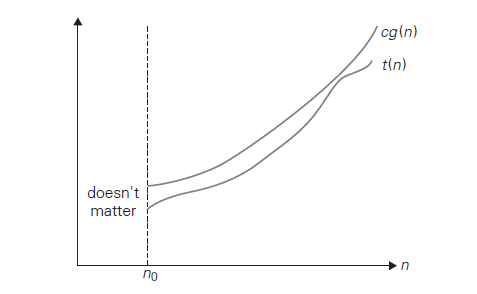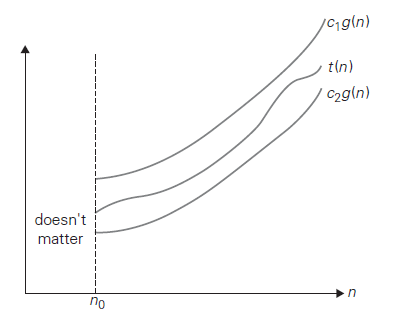Design of Algorithms
Analysis of Algorithms
Analysis of Algorithms
Table of Contents
- What analysis measures
- Running time
- Orders of Growth
- Efficiencies
- Asymptotic Notations
- Comparing Orders of Growth
- Efficiency Classes
- Process: Analysing time efficiency of non-recursive algorithms
- Process: analysing time efficiency of recursive algorithms
What analysis measures
- time complexity/efficiency: how fast an algorithm runs
- space complexity/efficiency: amount of space needed to run an algorithm and space required for input/output
- most algorithms run longer on longer inputs, so consider efficiency as a function of input size $n$
- when input is a single number, and $n$ is a magnitude (e.g. checking if $n$ is prime), you measure size using $b$, the number of bits in $n$’s binary representation: \(b=\lfloor\log_{2}n\rfloor+1\)
Running time
- counting all operations that run is usually difficult and unnecessary
- instead identify basic operation that has highest proportion of running
time and count number of times this is executed
- usually most time-consuming operation on innermost loop
- e.g. sorting: basic operation is key comparison
- arithmetic: (least time consuming) addition ~ subtraction < multiplication < division (most time consuming)
- time complexity analysis: determine number of times basic operation is executed for input size $n$
Orders of Growth
- small $n$: differences between algorithms are in the noise
- large $n$: the order of growth of the time complexity dominates and differentiates between algorithms
Some functions \(\log_{2}n < n < n\log_{2}n < n^2 < n^3 < 2^n < n!\)
-
$\log$ grows so slowly you would expect an algorithm with basic-operation to run practically instantaneously on inputs of all realistic size
- change of base results in multiplicative constant, so you can simply write $\log n$ when you are only interested in order of growth \(\log_a n = \log_a b \log_b n\)
- $2^n$ and $n!$ are both exponential-growth functions. Algorithms requiring an exponential number of operations are practical for solving only problems of very small size
Efficiencies
Algorithm run-time can be dependent on particulars of input e.g. sequential search
Efficiency can be:
- worst-case: algorithm runs longest among all possible inputs of size $n$
- best-case: algorithm runs fastest among all possible inputs of size $n$
- average-case: algorithm runs on typical/random input; typically more difficult to assess and requires assumptions about input
- amortized: for cases where a single operation could be expensive, but remainder of operations
occur much better than worst-case efficiency
- amortize high cost over entire sequence
Asymptotic Notations
Notations for comparing orders of growth:
- $O$: big-oh; $\le$ order of growth
- $O(g(n))$: set of all functions with lower/same order of growth as $g(n)$ as $n\rightarrow\infty$
- $\Omega$: big-omega; $\ge$ order of growth
- $\Theta$: big-theta; $=$ order of growth
e.g.
\(n \in O(n^2)\)
\(\frac{n}{2}(n-1)\in O(n^2)\)
\(n^3\not\in O(n^2)\)
Definition: A function $t(n) \in O(g(n))$ if $\exists c \in \R^+, n_0 \in \Z^+$ s.t. $\forall n\ge n_0$: \(t(n) \le cg(n)\)

Big O
Definition: A function $t(n) \in \Omega(g(n))$ if $\exists c \in \R^+, n_0 \in \Z^+$ s.t. $\forall n\ge n_0$: \(t(n) \ge cg(n)\)
Definition: A function $t(n) \in \Theta(g(n))$ if $\exists c_1,c_2 \in \R^+, n_0 \in \Z^+$ s.t. $\forall n\ge n_0$: \(c_1 g(n) \le t(n) \le c_2 g(n)\)

Big $\Theta$
Theorem: If $t_{1}(n) \in O(g_{1}(n))$ and $t_{2}(n) \in O(g_{2}(n))$: \(t_{1}(n)+t_{2}(n) \in O(\max\{g_{1}(n), g_{2}(n)\})\)
Analogous assertions also hold for $\Omega$, $\Theta$
- This implies that an algorithm comprised of two consecutively executed components has an overall efficiency determined by the part with a higher order of growth (the least efficient part)
- e.g.: check if an array has equal elements by first sorting, then checking consecutive items for equality
- part 1 may take no more than $\frac{n}{2}(n-1)$ comparisons, i.e. $\in O(n^2)$
- part 2 may take no more than $n-1$ comparisons, i.e. $\in O(n)$
- overall efficiency: $O(n^2)$
Comparing Orders of Growth
- to directly compare two functions, compute the limit of their ratio:
\(\lim_{n\rightarrow\infty}\frac{t(n)}{g(n)}\)
- This could be: ($\sim$: order of growth)
- $0: \sim t(n) < \sim g(n)$
- $c: \sim t(n) = \sim g(n)$
- $\infty: \sim t(n) \gt \sim g(n)$
- This could be: ($\sim$: order of growth)
- Case a, b $\Rightarrow t(n) \in O(g(n))$
- Case b, c $\Rightarrow t(n) \in \Omega(g(n))$
- Case b $\Rightarrow t(n) \in \Theta(g(n))$
L’Hopital’s rule
\[\lim_{n\rightarrow\infty}\frac{t(n)}{g(n)} = \lim_{n\rightarrow\infty}\frac{t'(n)}{g'(n)}\]Stirling’s Formula
For large $n$ \(n! \approx \sqrt{2\pi n}\frac{n}{e}^n\)
Efficiency Classes
| Class | Name | Comments |
|---|---|---|
| 1 | constant | very few algorithms fall in this class |
| $\log n$ | logarithmic | results from cutting problem’s size by constant factor |
| $n$ | linear | scan a list of size $n$ e.g. sequential search |
| $n\log n$ | linearithmic | divide-and-conquer e.g. mergesort; quicksort |
| $n^2$ | quadratic | two embedded loops e.g. basic sorting; $n\times n$ matrix operations |
| $n^3$ | cubic | three embedded loops; e.g. often used in linear algebra |
| $2^n$ | exponential | generate all subsets of $n$-element set |
| $n!$ | factorial | generate all permutations of $n$-element set |
Process: Analysing time efficiency of non-recursive algorithms
- define parameter indicating input’s size
- identify algorithm’s basic operation (typically on innermost loop)
- check if number of times basic operation is executed is only a function of input size
- if not: worst case, average case to be considered separately
- set up sum expressing number of times the basic operation is executed
- use formulas/sum manipulation to find a closed form solution for the count or determine order of growth
Basic rules
Scalar multiplication
\[\sum_{i=l}^{u}{ca_i} = c\sum_{i=l}^{u}{a_i}\]Addition
\[\sum_{i=l}^{u}{a_i+b_i} = \sum_{i=l}^{u}{a_i}+\sum_{i=l}^{u}{b_i}\]\(\sum_{i=l}^{u}1 = u-l+1\) In particular \(\sum_{i=1}^{n}{1} = n\)
Triangle numbers
\[\sum_{i=l}^{n}{i} = \frac{n(n+1)}{2}\]Geometric series
\[\sum_{i=1}^{n}{x^k} = \frac{1-x^{k+1}}{1-x}\]Process: analysing time efficiency of recursive algorithms
- define parameter indicating input size
- identify basic operation
- check if number of times basic operation is executed is only a function of input size
- if not: worst case, average case to be considered separately
- set up recurrence relation and initial condition corresponding to number of times basic operation is executed
- solve recurrence or ascertain order of growth of its solution
- solution of recurrence relation can be by:
- backwards substitution/telescoping method: substitution of M(n-1), M(n-2), …, and identifying the pattern
- can be helpful to build a tree of recursive calls, and count the number of nodes to get the total number of calls
Divide and Conquer
- binary/n-ary recursion is encountered when input is split into parts, e.g. binary search
- you see the term $n/k$ in the recurrence relation
- backwards substitution stumbles on values of $n$ that are not powers of $k$
- to solve these, you assume $n=k^i$ and then use the smoothness rule, which implies that order of growth for $n=k^i$ gives a correct answer about order of growth $\forall n$ For the following definitions, $f(n)$ is a non-negative function defined for $n \in \N$
DEFINITION: eventually non-decreasing
- eventually nondecreasing: if $\exists n_0 \in \Z^+$ s.t. $f(n)$ is non-decreasing on $[n_0, \infty]$, i.e.
\(f(n_1) \le f(n_2) ~~ \forall ~ n_2 > n_1 \ge n_0\)
- e.g. $f(n) = (n-100)^2$: eventually non-decreasing
- decreasing on interval $[0, 100]$
- most functions encountered in algorithms are eventually non-decreasing
- e.g. $f(n) = (n-100)^2$: eventually non-decreasing
DEFINITION: smooth
$f(n)$ is smooth if:
- eventually non-decreasing, AND
-
$f(2n) \in \Theta(f(n))$
-
e.g. $f(n) = n \log{n}$ is smooth because \(f(2n) = 2n \log{2n} = 2n(\log{2} + \log{n}) = 2 \log{2}n + 2n \log{n} \in \Theta(n\log{n})\)
- fast growing functions e.g. $a^n$ where $a > 1$, $n!$ are not smooth
- e.g. $f(n) = 2^n$ \(f(2n) = 2^{2n} = 4^n \not\in\Theta(2^n)\)
THEOREM:
Let $f(n)$ be smooth. For any fixed integer $b\ge 2$: \(f(bn)\in\Theta(f(n))\) i.e. $\exists c_b, d_b \in \R^+, n_0 \in \Z^+$ s.t. \(d_b f(n) \le f(bn) \le c_b f(n) \text{ for } n\ge n_0\)
- corresponding assertion also holds for $O$ and $\Omega$
THEOREM: Smoothness rule
Let $T(n)$ be an eventually non-decreasing function Let $f(n)$ be a smooth function. If $ T(n) \in \Theta(f(n)) $ for values of $n$ that are powers of $b$ where $b\ge 2$, then: \(T(n) \in \Theta(f(n))\)
- analogous results also holds for $O$ and $\Omega$
- allows us to expand information about order of growth established for $T(n)$, based on convenient subset of values (powers of $b$) to entire domain
THEOREM: Master Theorem
Let $T(n)$ be an eventually non-decreasing function that satisfies the recurrence \(T(n)=aT(n/b)+f(n) \text{ for } n= b^k, k = 1, 2, ...\) \(T(1) = c\) where $a\ge1,b\ge2,c>0$. If $f(n)\in\Theta(n^d)$ where $d\ge0$, then \(T(n)\in\begin{cases}\Theta(n^d)\text{ if }a<b^d\\\ \Theta(n^d\log{n})\text{ if }a=b^d\\\ \Theta(n^{\log{a}_b)}\text{ if }a>b^d\end{cases}\)
- analogous results also holds for $O$ and $\Omega$
- helps with quick efficiency analysis of divide-and-conquer and decrease-by-constant-facotr algorithms